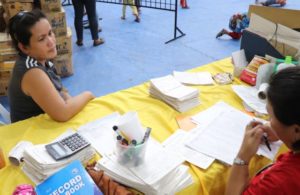
Flordeliza Lapitan (left), 43, consults with a health worker at the Enan Chiong Activity Center regarding her son Jack’s stomachache.
contributed photo
Flordeliza Lapitan tried to keep her composure as she shared about her 9-year-old son Jack’s stomach pains with the resident health worker at the Enan Chiong Activity Center (ECAC) on the morning of October 12.
Her voice was calm while answering the nurse’s questions like how long has Jack been feeling that way or what could he have eaten in the past few days that might have caused it.
Underneath the consultation table, however, she was fidgeting with her hands and her red, puffy eyes revealed she hasn’t had decent sleep in recent nights.
“Bag-o ra man to naayo akong anak sa hilanat duha ka adlaw na ang nilabay unya karon nireklamo man siya nga sakit iyang tiyan. Nagsugod na sad siya og ubo ug sip-on. Bisan kinsa man tingali nga ginikanan makakita sa iyang anak magluya kay mabalaka sad,” she shared.
(My son was just getting better from fever two days ago and now he’s complaining about a stomachache. He’s also started showing signs of cough and colds. Any parent whose child is going through all this in a place that isn’t home would be worried.)
Jack caught a fever about two weeks after their family moved to ECAC in Naga City, Cebu, where more than 350 other families or close to 1,500 individuals were evacuated after a massive landslide struck Sitio Sindulan in Barangay Tinaan last Sept. 20.
Evacuees at the ECAC, as well as thousands of others across various evacuation centers spread across the city and the neighboring town of San Fernando, have learned to disregard personal space.
The evacuation center’s bleachers explode with bright hues of red, yellow, blue, and green as if banderitas were haphazardly strewn across the place, but these only turn out to be belongings of the hundreds of families staying there.
While some have folding beds, most of the evacuees sleep on mats on the floor, with no partitions to separate one family from another.
“We’re doing fine here because our basic needs are provided, but it just isn’t home. Since we can’t go back yet, we’ll just have to endure this as a family,” Flordeliza said.
Dr. Porferia Daclan, ECAC camp manager, said that the most common health problems they have encountered in evacuation centers over the last three weeks are colds, cough, fever, as well as occasional cases of diarrhea.
“This is most likely because of the congestion and the humidity. While everything is still manageable, we could use all the help we can get,” she said.
In an effort to assist the city government of Naga and help alleviate the living conditions of evacuees, AboitizPower subsidiary Therma Power Visayas Inc. (TPVI) donated medicines worth P464,300 last October 12.
Chiong’s chief of staff, personally received the items in a turnover ceremony at the Naga City Health Office.
Disclaimer: The comments uploaded on this site do not necessarily represent or reflect the views of management and owner of Cebudailynews. We reserve the right to exclude comments that we deem to be inconsistent with our editorial standards.
